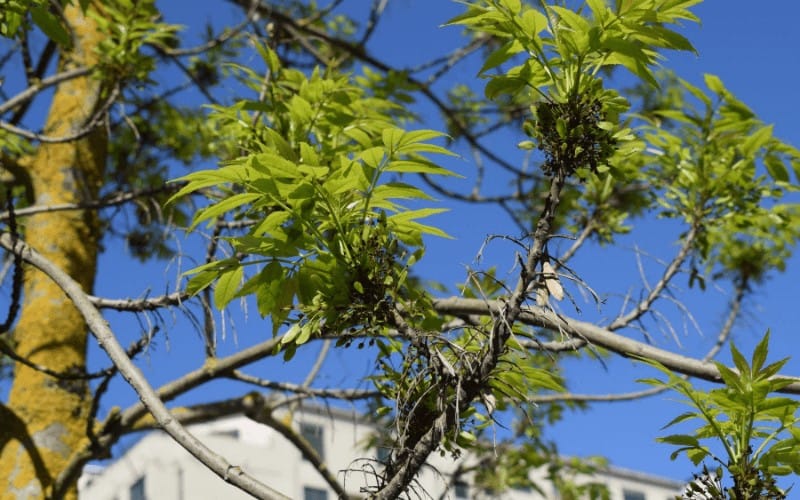Training tree branches to go where you want is a form of tree care that is known as structure altering or tree training. People often confuse it as tree pruning.
However, tree pruning is different from tree training, in that tree pruning helps maintain the proper shape of a tree, encourages the growth of healthier fruits, and prevents diseases.
On the other hand, tree training or structure altering directs a tree in a particular direction. It alters the structure of the tree into something you desire. If a tree is properly trained from the onset, there is usually no need for pruning at the tree's later years.
Now, let us get to understanding how to train tree branches to go where you want.
Table of Contents
Why You Should Train Tree Branches
You may wonder, why should I train my tree branches to go where I want, instead of where nature wants and have intended to keep it. Naturally, trees tend to grow wildly, occupying any available space they see, and most of all, providing shelter for all the birds and creatures that care to find a home in it.
The problem that arises when we grow these trees is space. We do not have ample spaces in our home to accommodate all of these trees' wildness and the creatures that find solace in them.
As a result of limited space in our homes and places of habitation, there is a need to train these tree branches to go where you want them to go and take up any shape you so desire.
To conserve spaces and improve your home or garden's aesthetics, there is an urgent need to train your tree branches.
And to do so, you would need to combine other gardening skills such as pruning, grafting, and tying to achieve your desired tree shape and height, while maximizing its ability to produce fruits.
Training Tree Branches to Go Where You Want
Tree training has been in practice for not so long ago and can be carried out as easily as tying down tree branches or propping up tree branches from the ground.
The tree branches grow in the path of the tied direction. This procedure is carried out at the early stage of the tree to enable it to develop fully in the guided direction.
Tree training is usually carried out in the summer, and its mechanism can be regarded as carrying out orthodontics for the tree.
The procedure which involves tying or propping pulls or pushes the branches like an orthodontic brace does to the human teeth, in whatever direction you want them to go to. However, eventually, they grow into that shape as a result of training.
Having discussed and hoping that you have understood why you should train tree branches to go where you want, we would now go into understanding how to go about tree training or tree structure altering.
Read Also: Can a Broken Tree Branch Grow Roots?
How to Train a Tree Branch to Any Direction
Tree training begins a year after transplanting the tree and continues through the next few years, usually three to five years ahead. Tree training should be completed at the eight or tenth year, after which other maintenance procedures such as pruning are carried out.
Tree training is usually done at the growing period of a tree, while the maintenance procedures such as pruning are carried out during the dormant season.
You decide on what system of training you would adopt for the tree during planting. And this decision is usually based on the tree's species and its growth habits.
Take, for instance, trees such as sycamore and oaks usually develop into a central leader, while trees like mulberry and elm usually fork in between the main trunk.
So, for such trees, you need to develop an improved central leader. This modified or improved central leader is the most preferred training system for fruit trees that also serve as yard trees.
At the tree's growing stage, you must visualize how you want the tree to look like in years to come when it has grown to full maturity.
Depending on the tree's branching structure, and growth rate, it may take up to several years for the training to take full effect, and the tree takes up and retains the shape it's been trained to take.
How to Care For A Tree While Training Its Branches
During the early stages of the tree training, you are expected to frequently inspect the tree to make necessary corrections should there be a need to adjust any part of the growing tree branches.
Then at the end of the season, after the leaves have all fallen, re-inspect the tree and make necessary corrective cuts where needed.
Do not cut back the tip of the main trunk of the young tree. Heading back at this point is not encouraged as it is not beneficial to most trees and, most times, leads to the appearance of undesirable forks in the main trunk.
This happens mostly in trees whose species fork, such as maple and elm. Side branches may be shortened during planting if there is a need for that.
Tree branches of ornamental species and fruit trees should not have their branches anywhere closer than four to five feet above the ground level, nor should they be planted anywhere where there lower branches would interfere or obstruct routine recreational activities or lawn mowing.
Trees such as Amur maple bears heavy fruits, and these fruits can distort the shape of the tree, thereby attempting to defeat the aim of the tree training. To avoid this, you can either remove the fruits or brace the tree.
Conclusion
Training tree branches to go where you want is quite possible and highly achievable. In order to get the best tree training result, it is recommended that you train the tree during the summer and while the tree is still young.
Frequent inspection is necessary to enable you to diagnose problematic traits and correct them as soon as possible when the tree is still developing.
Trees that bear heavy fruits are usually braced, or their fruits are removed to maintain the shape of the tree and achieve the desired shape for which it is being trained.







